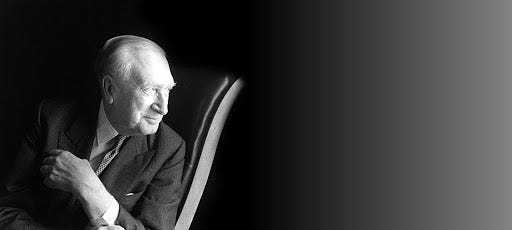
Why do certain pieces capture the time in which they’re written? Obviously, it takes retrospect in order for this rare occurrence to happen at all, but in the case of William Walton’s Symphony №1, the acknowledgement was immediate. With pieces like this, I’ve always felt that somehow I’ve heard it before, as if it’s always been with me. If someone would use this phenomenon to posit the existence of reincarnation, I just might believe them!
By the early thirties, Walton had achieved considerable renown as, at first, an avant garde composer with theater works like Façade, but quickly became a composer of national stature with works such as his Viola Concerto and the cantata, Belshazzar’s Feast. He was a slow, methodical composer who would often take many months, if not years to finish a work and this was certainly the case with his first symphony. Walton began composing it in 1932 and at first he made decent progress, finishing the first two movements by the beginning of the 1933. He was able to finish the third movement by the middle of the same year, but then he hit a roadblock and simply could not finish the last movement. It would take him another two years to do so.
Some have offered the theory that it was due to the end of a six-year affair to the person for which the symphony is dedicated, Baroness Imma von Doernberg. However, another argument was that he had no real impetus to finish it because it wasn’t being written on commission. Whatever the case, he stopped working on the symphony entirely and began other projects, including the soundtrack to the film, Escape Me Never. However, people were so eager to hear what he had finished, including the conductor Sir Hamilton Harty, that he was persuaded to allow the first three movements to be performed on their own. Harty conducted the first three movements in performance on December 3, 1934.
Walton didn’t complete the symphony until August 3, 1935, and Sir Harty conducted the premiere with the BBC Symphony Orchestra November 6, 1935. A review of that premiere states, “The applause at the close was overwhelming, and when Mr. Walton, a slim, shy, young man, came on to the platform he was cheered continuously for five minutes.” Conductor from around the world asked for scores and it quickly became commonplace in the concert hall, particularly England.

Surprisingly, however, it didn’t get recorded very often at first. Admittedly, it’s an incredibly piece to perform and I have witnessed very competent conductors and orchestras lose their bearings in this piece. A great performance requires a relentlessness and constant drive that’s very difficult to maintain, both for the conductor and the orchestra. Of all of the recordings that have been made, there are only a few that can keep this tension from the first bar to the last.
